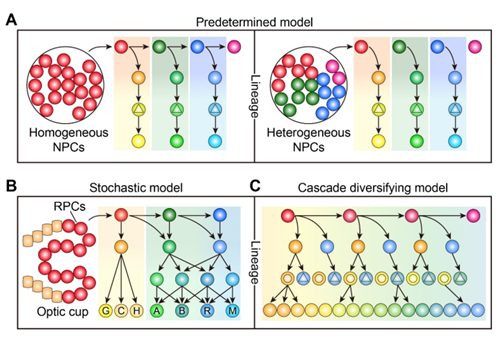The complexity and function of the nervous system relies on the generation of unparalleled neuronal diversity across molecular, morphological, functional and connectional features throughout developmental continuum. However, the strategies to generate neuronal diversity across different brain regions during development remain enigmatic.
Strategies for generating neuronal diversity in cerebral cortex, retina and hypothalamus (Image by IGDB)
Recently, a review published in Neuroscience Bulletin, led by Dr. WU Qingfeng from Institute of Genetics and Developmental Biology, Chinese Academy of Sciences (CAS), illustrated three distinct strategies deployed by neural progenitors to produce diverse neuronal subtypes: (1) predetermined model characterized by the fate specification of neural progenitors into an invariant neuronal subtype within a specified time window; (2) stochastic model suggesting that cell fate resembles quantum particles existing in a superposition of states, each occurring with different probabilities until direct observation restricts the probable outcomes to one state; and (3) cascade diversifying model demonstrating that multiple cell types including neural progenitors and neuronal precursors along the lineage hierarchy contribute to neuronal fate diversification in a stepwise manner.
In combination with the spatiotemporal developmental patterns of nervous system, the review summarized the developmental process of neural progenitor cells within cerebral cortex, spinal cord, retina and hypothalamus.
It is also notable that microenvironmental cues, spontaneous activity and connectional pattern further reshape and diversify the fate of unspecialized neurons in particular regions. The illumination of how neuronal diversity is generated will pave the way for producing specific brain organoids to model human disease and desired neuronal subtypes for cell therapy, as well as understanding the organization of functional neural circuits and evolution of nervous system.
Taken together, this review provides deep insights into the mechanisms of generating neuronal diversity, which will provide profound theoretical support for brain development and neuronal therapy.
Contact:
WU Qingfeng
Institute of Genetics and Developmental Biology, Chinese Academy of Sciences
Reference:
A Spacetime Odyssey of Neural Progenitors to Generate Neuronal Diversity
 Strategies for generating neuronal diversity in cerebral cortex, retina and hypothalamus (Image by IGDB)Recently, a review published in Neuroscience Bulletin, led by Dr. WU Qingfeng from Institute of Genetics and Developmental Biology, Chinese Academy of Sciences (CAS), illustrated three distinct strategies deployed by neural progenitors to produce diverse neuronal subtypes: (1) predetermined model characterized by the fate specification of neural progenitors into an invariant neuronal subtype within a specified time window; (2) stochastic model suggesting that cell fate resembles quantum particles existing in a superposition of states, each occurring with different probabilities until direct observation restricts the probable outcomes to one state; and (3) cascade diversifying model demonstrating that multiple cell types including neural progenitors and neuronal precursors along the lineage hierarchy contribute to neuronal fate diversification in a stepwise manner.In combination with the spatiotemporal developmental patterns of nervous system, the review summarized the developmental process of neural progenitor cells within cerebral cortex, spinal cord, retina and hypothalamus.It is also notable that microenvironmental cues, spontaneous activity and connectional pattern further reshape and diversify the fate of unspecialized neurons in particular regions. The illumination of how neuronal diversity is generated will pave the way for producing specific brain organoids to model human disease and desired neuronal subtypes for cell therapy, as well as understanding the organization of functional neural circuits and evolution of nervous system.Taken together, this review provides deep insights into the mechanisms of generating neuronal diversity, which will provide profound theoretical support for brain development and neuronal therapy.Contact:WU QingfengInstitute of Genetics and Developmental Biology, Chinese Academy of SciencesEmail: wu_qingfeng@genetics.ac.cnReference:A Spacetime Odyssey of Neural Progenitors to Generate Neuronal Diversity
Strategies for generating neuronal diversity in cerebral cortex, retina and hypothalamus (Image by IGDB)Recently, a review published in Neuroscience Bulletin, led by Dr. WU Qingfeng from Institute of Genetics and Developmental Biology, Chinese Academy of Sciences (CAS), illustrated three distinct strategies deployed by neural progenitors to produce diverse neuronal subtypes: (1) predetermined model characterized by the fate specification of neural progenitors into an invariant neuronal subtype within a specified time window; (2) stochastic model suggesting that cell fate resembles quantum particles existing in a superposition of states, each occurring with different probabilities until direct observation restricts the probable outcomes to one state; and (3) cascade diversifying model demonstrating that multiple cell types including neural progenitors and neuronal precursors along the lineage hierarchy contribute to neuronal fate diversification in a stepwise manner.In combination with the spatiotemporal developmental patterns of nervous system, the review summarized the developmental process of neural progenitor cells within cerebral cortex, spinal cord, retina and hypothalamus.It is also notable that microenvironmental cues, spontaneous activity and connectional pattern further reshape and diversify the fate of unspecialized neurons in particular regions. The illumination of how neuronal diversity is generated will pave the way for producing specific brain organoids to model human disease and desired neuronal subtypes for cell therapy, as well as understanding the organization of functional neural circuits and evolution of nervous system.Taken together, this review provides deep insights into the mechanisms of generating neuronal diversity, which will provide profound theoretical support for brain development and neuronal therapy.Contact:WU QingfengInstitute of Genetics and Developmental Biology, Chinese Academy of SciencesEmail: wu_qingfeng@genetics.ac.cnReference:A Spacetime Odyssey of Neural Progenitors to Generate Neuronal Diversity CAS
CAS
 中文
中文




.png)
